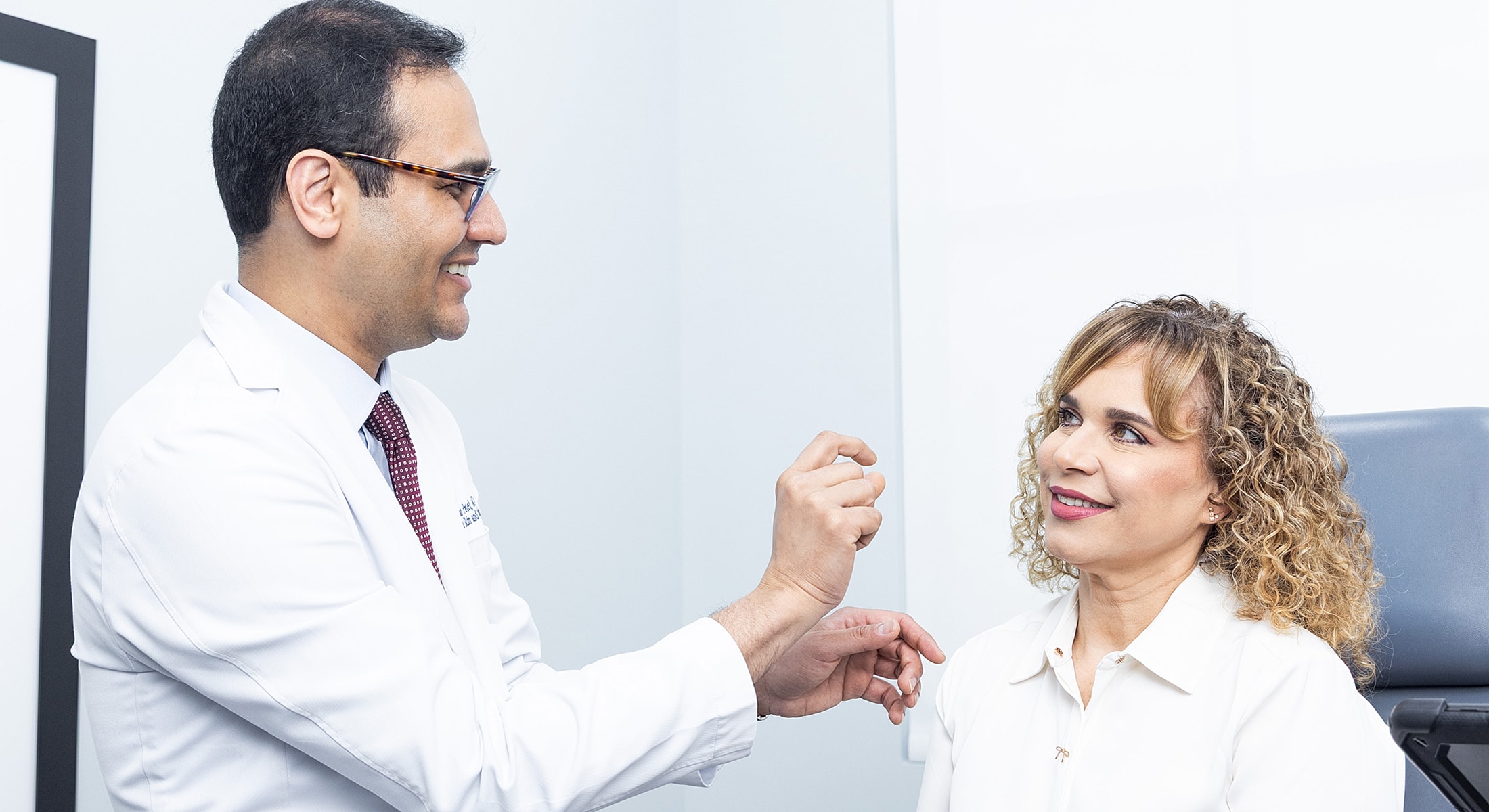Dark Spot Treatment in Miami










Clear, Even Skin — Expertly Restored
Brown spots and discoloration—whether caused by sun exposure, hormones, or past breakouts—can make your skin appear older, uneven, and dull.
At Miami Skin + Vein, we take a physician-led, evidence-based approach to treating dark spots in all skin tones, including deeper and melanin-rich complexions, where precision matters most. Led by Dr. Shaun Patel, a nationally recognized laser expert, we use state-of-the-art technology and advanced techniques to safely fade dark spots and restore a balanced, luminous complexion. Whether you're dealing with sun spots, melasma, or post-acne discoloration, we design each treatment plan to fit your skin, your goals, and your lifestyle.


A Targeted Approach
Dark spots—sometimes called sun spots, liver spots, or age spots—are areas of excess melanin in the skin, often triggered by UV exposure, inflammation, or hormonal changes. These spots may appear on the face, chest, hands, or anywhere the skin has been exposed to the sun or trauma.
At Miami Skin + Vein, we specialize in light- and laser-based technologies and chemical peels to address pigment at its source. Treatments are tailored to your skin tone and the depth of the pigment, with particular care taken for darker skin types to minimize risk and ensure optimal results. Our most effective treatments include:

Using ultrafast picosecond pulses, PicoWay targets pigment clusters without generating unnecessary heat. PicoWay is ideal for treating melasma and post-inflammatory dark spots in all skin tones, including darker complexions.

This broadband light therapy is ideal for sun-induced discoloration like age spots and UV-related freckles. Most effective in lighter skin types, IPL can be used to treat the face, neck, chest, and hands.

Fractional CO₂ is a deeper resurfacing option that removes layers of damaged skin and stimulates collagen production. Best for textural irregularities and pigment in fair to medium skin tones, this treatment also improves fine lines and sun damage.

These non-ablative fractional lasers gently penetrate below the skin’s surface to treat brown patches, acne-related dark marks, and early melasma without requiring extensive downtime.

Topical peels with kojic acid, azelaic acid, glycolic acid, or tranexamic acid help lighten surface pigmentation while brightening and refining skin tone. These peels are often used alone or in between laser sessions as part of a maintenance plan.
Advanced Techniques for Reversing Damage
We begin every treatment with a one-on-one consultation and a close evaluation of your skin tone, spot type, and medical history. Based on your skin’s unique biology, Dr. Patel will recommend a customized treatment plan.
Most sessions last between 20 and 60 minutes. Depending on your plan, your treatment may involve:
Some patients see improvement after a single session, but a series is often recommended for the best results, especially for stubborn or deeper pigmentation.

Clarity Without Compromise
We successfully treat a wide range of discoloration concerns, including:

Brighter Skin Starts Here
If you’re bothered by brown spots or discoloration and want to improve your skin’s tone and clarity without harsh or invasive procedures, our advanced treatments may be ideal for you. Patients with darker skin tones, sensitive skin, or melasma benefit from Dr. Patel’s conservative, expert-calibrated approach.
We’ll take into account your pigment type, skin tone, medical history, and current skincare routine to select the safest and most effective treatment. Some medications or conditions, like pregnancy or active rashes, may require you to delay treatment. Our goal is to give you real, lasting improvement without risk or guesswork.

Visible Improvement, Long-Term Clarity
You’ll likely start to see your skin brighten within the first few weeks, with dark spots fading gradually as excess melanin breaks down and new skin cells emerge.
A series of 3–6 sessions may be recommended depending on the cause, depth, and location of your discoloration. Long-term success depends on both expert treatment and intentional aftercare. With our guidance, you’ll know exactly how to protect your results, avoid recurrence, and maintain clear, even-toned skin year-round.

What to Expect After Treatment
Recovery will depend on which treatment you receive. Most non-ablative options involve little to no downtime. Here’s a general overview:
After your session, we’ll give you a post-care guide that may include:
With consistent care, your results can be long-lasting, especially when paired with at-home maintenance.
The Art and Science of Skin Renewal
At Miami Skin + Vein, treating brown spots isn’t just cosmetic—it’s a science. With advanced tools, proven techniques, and years of experience treating all skin tones, Dr. Shaun Patel delivers exceptional outcomes with safety and subtlety.
As a Key Opinion Leader for Candela Medical, Dr. Patel trains other providers in safe, effective use of laser technology. When you come to us for brown spot treatment, you're receiving care from a physician who not only understands pigment but leads the field in how to treat it. Clearer skin begins with a consultation. Contact us today to start your personalized dark spot treatment.
Recommended Products
Brown spots typically result from excess melanin production triggered by sun exposure, inflammation, acne, hormonal changes, or skin trauma. Over time, this pigment collects in the upper layers of the skin, leading to discoloration that can be difficult to fade without professional treatment.
While all three involve increased melanin, brown spots (also known as sun spots or age spots) are usually caused by UV exposure and are more superficial. Melasma tends to be UV exposure and hormonally driven and often appears in larger patches, while post-inflammatory hyperpigmentation (PIH) follows acne or injury. Dr. Patel carefully distinguishes between these conditions to tailor the safest and most effective treatment for each patient.
Most patients see visible improvement after 1–2 sessions, but a series of 3–6 treatments is often recommended for optimal, lasting correction. The exact number depends on the type of pigmentation, your skin tone, and the modality used.
Yes. Miami Skin + Vein specializes in treating patients with all skin tones, including darker skin types. Dr. Patel customizes energy settings and selects pigment-safe protocols to minimize the risk of post-treatment hyperpigmentation or irritation.
IPL (intense pulsed light) targets pigment closer to the surface and works best on lighter skin with UV-related discoloration. Lasers like PicoWay and Frax use precise wavelengths to break up deeper pigment and can be used safely across a wider range of skin tones, including Fitzpatrick IV–VI.
They can—especially with unprotected sun exposure or if underlying causes like hormones or inflammation persist. We provide a personalized aftercare plan, including SPF, topical maintenance, and long-term pigment management, to help keep your skin clear and prevent recurrence.
Downtime varies. PicoWay and IPL treatments usually involve minimal redness and flaking. Chemical peels may cause mild dryness or peeling for 2–5 days, while CO₂ laser resurfacing may require 7-14 days of healing. We'll recommend a treatment that fits your lifestyle and preferences.
Absolutely. Many patients benefit from a combination approach, such as pairing laser therapy with chemical peels or using topical agents in between treatments. Dr. Patel will design a plan that supports your skin from multiple angles without overwhelming it.
Fall and winter are ideal because there’s less UV exposure. However, with strict sun protection and proper aftercare, we can safely treat brown spots year-round in our Miami clinic.